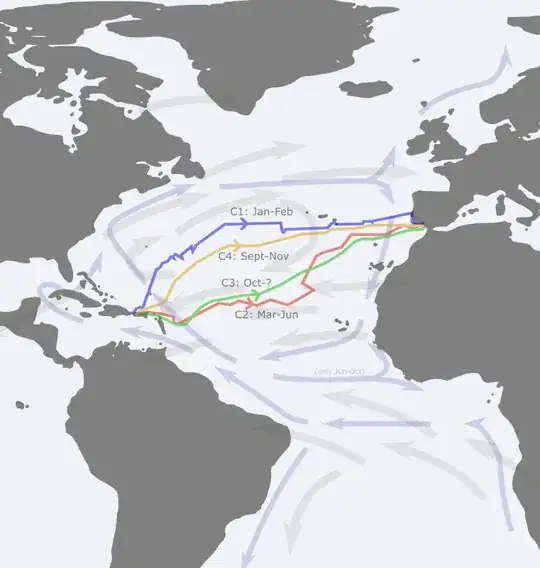Given:
- An ahistorically powerful and advanced Aztec civilisation, anno late 1400s.
- A set of circumstances much like the ones that led Columbus west: one mad Aztec convinced the world was rather small and he could reach their trading partners (the Chinese) by sailing eastwards.
He sets sail from Haiti, the latest Aztec tributary. The season is undetermined. He has no knowledge of what he'll find on the other side, other than vague records of mythical place called Hindustan.
Where will he land?
Ship facts:
- It's built for mainly the Gulf of Mexico, Caribbean sea and coastal waters from Georgia to Venezuela, but large enough to carry lots of tribute - which they now fill with supplies for the journey instead. Think a slightly smaller, Mesoamerican version of Zheng He's famous treasure ship.
- There's at least one person aboard who's acquainted with oceanic travel (a Chinese defector - who in this reality regularly crossed the Pacific). The crew at large makes up for their lack of expertise in spirit though.
- They do not have a clue what's on the other side of the Atlantic; their goal is to reach China. They do not know any currents that only reveal themselves far past the shores. They are going to have to discover all those things on the way east.
Sea facts:
Both the prevailing winds and the ocean currents (gyres) suggest a somewhat northerly course to be "ideal"; going parallel to the North American coast for a bit and ending up in Europe.
But if you look at Columbus' travels, and specifically the return trips, only on his first journey does he curve northward significantly before heading east, and it looks like he was specifically aiming for the Azores that time. So it is definitely not against the laws of physics to sail a straight eastbound path, which would have our brave Aztec land in Cape Verde or Mauritania.
So I wonder if there's an argument to be made that given a sailor with a suitable vessel but little knowledge of the deep ocean (just like Columbus) and no known destination to aim for, that a spot on the Atlantic coast from Senegal to Portugal is most likely to be hit?
Or are those prevailing winds/currents so strong and noticeable that any reasonable sailor encountering them for the first time would be compelled to adopt a more northerly course, and end up somewhere between Tanger and Scotland?
Or is it all so dependent on the season and weather conditions of the time that any destination between those northern and southern extremes is at least plausible?
Update
So I did some more research and I made a map.
Fat arrows are winds, thinner arrows are ocean streams (of which the equatorial counter-current is only active in the late summer and autumn, apparently). The lines are all the west-east Atlantic crossings I could find the routes and dates for; just Columbus' four journeys. Don't really know where else to look.
It's... not that helpful in the end. Columbus crossed the Atlantic in basically every season, and he only followed the currents or winds twice.
Safe to say that I'm starting to lean towards any landing site for my Nahuatls to be plausible. If Columbus could take those routes in spite of wind and currents, couldn't my expedition do the same?
